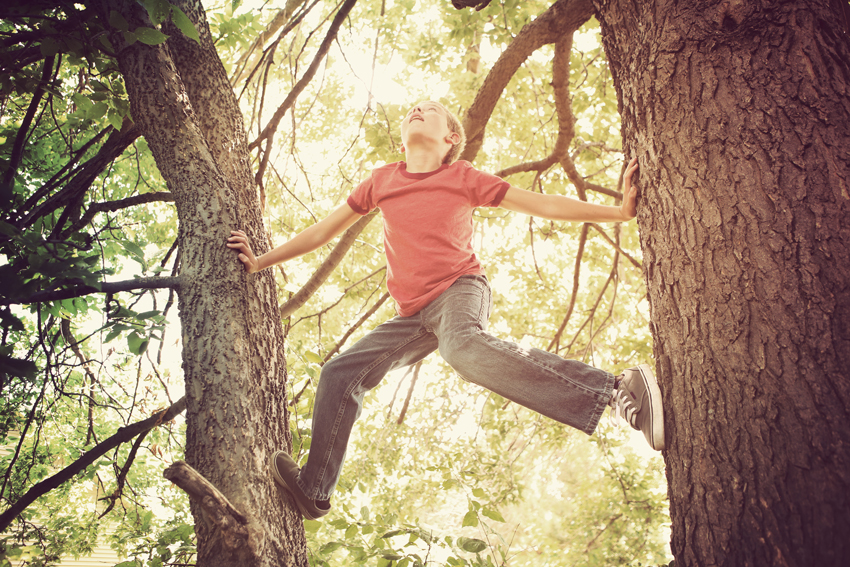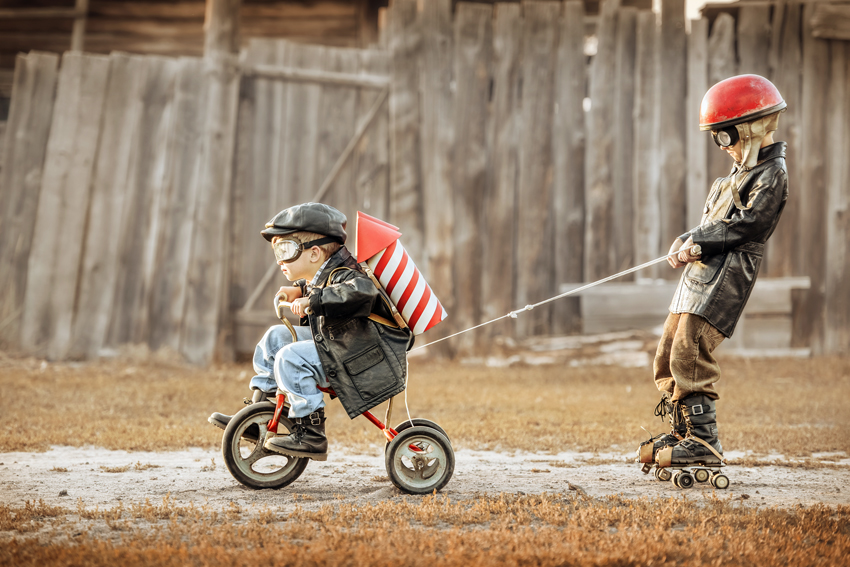
Building a More Playful World
Ella Jane Mortensen | March 31, 2025
Imagine two children playing together. They start out as cashier and customer, playing pretend “store.” Then it seems to go in a different direction, involving the purchase of pet dragons. But grocery stores don’t sell dragons, in fact they don’t usually sell any live animals at all. Now the children are on a different adventure, rescuing dragons from grocery store cages and flying around with their new dragon friends. It doesn’t follow adult logic, but that’s the point. These children are undergoing a process that is much more fundamental than they—or we—realize.
Through imaginative play, they are building the foundation of exploratory thinking and creativity that will shape their brains for the rest of their lives. The desire to play is not just frivolous, it is instinctual. As children become more attached to technologies that promote the consumption of content while being immersed in a culture of achievement, their play instincts are smothered, inhibiting the development of their natural creativity and curiosity. Loosening the reins on childhood is essential for kids’ development and for the cultivation of a creative culture that is able to adapt to future challenges.
Most of what we know about the neurobiological effects of play comes from numerous studies by the Estonian-American neuroscientist Jaak Panksepp, who researched the play behavior of rats. Panksepp removed the neocortex, the most recently evolved outer layer of the brain, and studied the play behavior of the rats. Contrary to expectations, these rats engaged in play in the same ways as rats with intact brains, suggesting that play is a deeply ingrained mammalian behavior.
Panksepp found that “Mammalian play urges, clearly built into the nervous systems, are likely to be social experience-expectant processes that allow the young to learn the specific social nuances of their species. Play not only helps the young to acquire and refine social skills, […] but also does so in the safety of supportive adult social groups that can provide feedback on their behaviors.”

Panksepp also found that play behavior is associated with the release of endogenous (self-made) opioids and dopamine. These hormones interact with the prefrontal cortex, allowing it to become “less rigid,” which helps both rats and people to take on different roles and explore imaginative scenarios. Beyond its benefits for role-playing, this lessened rigidity can be advantageous in a general sense for humans as they navigate through life and can use that flexibility to better problem-solve, or to simply understand the world more clearly.
The benefits of play can thus seem intuitive, yet its precise definition can still be fuzzy. Peter Gray, a prominent author and play researcher at Boston College, defines play based on four key concepts. (According to Gray, these criteria describe play in its purest form. However, an activity that meets only some of these standards may still qualify as playful, and can have the benefits of play.) In an article on his personal website, Gray details the criteria of play:
- Play is self-chosen and directed. The player must make an active choice to engage in play, whether social play with others or alone. The player should also have some agency in determining the activity and the nature of the game.
- Play is intrinsically motivated. The means should be more valued than the ends. The goal of the game must not be to win, but to have an experience.
- Play is based on rules in the player’s own mind, rather than directed by the rules of a supervisor such as a teacher, coach, or rule book.
- Play is imaginative and creative. Anything is possible and it is up to the player what world they want to live in. Gray writes, “Play is embodied fiction.”
Play is usually highly social, and it is within this arena that children learn how to cooperate with others and operate under conceptual rules (much like our human society). As in the pretend store scenario, when one child introduces an unexpected concept, they invite the other to add onto it within the assumption that they are in a store. If one child introduces a new concept, such as, “I’d like to buy a dragon please,” this allows the other child to expand the situation, perhaps by responding “Oh no! All the dragons escaped. We need to capture them!” Children learn through these experiences how to cooperate with others, not pushing for their own way, but sacrificing immediate desires for the good of the game.
Children in a play state of mind are engaged, focused, and curious. They take risks freely and are not deeply afraid of the consequences. Social psychologist Jonathan Haidt, in his book The Anxious Generation, writes that in play, “mistakes are generally not very costly.” In situations where mistakes have more serious consequences, norepinephrine, the adrenaline hormone, is released and “play circuitry” is inhibited. High-adrenaline activities, such as competitive sports games, can benefit older children by teaching them how to work with others towards a goal. However, these high-pressure scenarios may not be advantageous to young children whose brains are wired for exploratory play.
Peter Gray wrote about a recent study suggesting that reducing children’s free play for academic pressure may harm long-term success. In Tennessee, a state-wide program introduced a new and ambitious type of preschool, which placed emphasis on early academic rigor by providing 5.5 hours of daily instruction to their four-year-old students. The National Institute for Early Education Research (NIEER) placed the program as meeting 9 out of its 10 standards for an ideal preschool program, and students were found to outperform peers in early grades. However, by sixth grade, the same group of students lagged academically, had more disciplinary infractions, and were more likely to be diagnosed with learning disabilities than their peers who did not attend. Gray writes that the results may point not to what happened during instructional hours, but what failed to happen at home.
“Four-year-olds need lots of time to play, create, socialize, take initiative, figure things out on their own, and learn to manage themselves,” Gray writes. “The time spent in academic training is time that they cannot spend on learning the much more important skills that come from self-directed activities.”
Academic success tends to be evaluated quantifiably. People are quick to understand that a report card that awards a student with ‘100’s’ or ‘A’s’ means that they did well. Abilities such as the ones described here by Gray—getting along with others, self-organization, emotional regulation, initiative and creativity—are more conceptual and harder to evaluate, yet it is more often these qualitative skills that determine an individual’s ability to create a fulfilling life.

Play environments where children are encouraged to explore their curiosities, take risks, and build cooperative connections with others should be facilitated by parents and educators. Providing children with a warm and supportive environment where creative play is encouraged can lead to positive associations with exploration and creativity. Children’s brains are extremely flexible and plastic, highly receptive to suggestion from adults and from experiences with playmates. This is a time where unconscious associations are constantly being formed. As children grow into adults, these deep-down associations remain and contribute to the formation of the automatic mental pathways of the adult mind.
In adulthood, the brain is like a mature forest with many trails; the routes that get traveled often become the most open and accessible, while new patterns are harder to develop. Brains in early childhood are quite different—they have far more neurons ready to make connections, and are like an open field that can be easily traversed. Children’s brains respond to play by developing skills that endure throughout a lifetime. Yet it is not just children who benefit from play. For adults, engaging in playful behaviors promotes flexible thinking; encouraging the development of new synapses and loosening rigid brain patterns. As described in this article from the National Institute for Play, a defining element of adult play is attitude. When an individual is playing, their mind is relaxed, open, and not seeking a concrete goal other than having fun. When we play, our minds open to different ways of thinking, helping us to solve problems and enjoy life more deeply. Encouraging play in childhood, when it is most instinctual and natural, helps to form adults who are more creative, adaptive, and resilient—able to more confidently experience the world in their own unique way.
Ella Jane Mortensen holds a BA in international studies, specialising in global health, the environment and Europe, with a minor in philosophy. Her work experience includes tutoring, textbook editing and teaching English in Spain.

